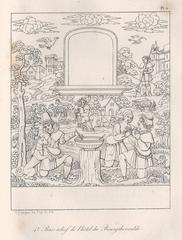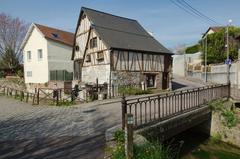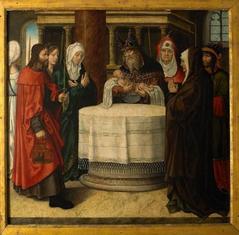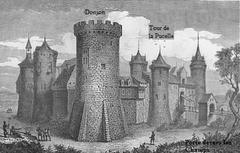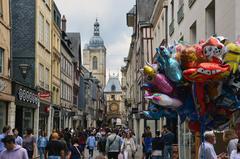
Visiting Hours, Tickets, and History of Église Saint-Gervais de Rouen: A Comprehensive Guide
Date: 04/07/2025
Introduction
Located in the heart of Rouen, Église Saint-Gervais de Rouen is a monument of enduring faith, resilience, and historical significance. With roots stretching back over a millennium, this neo-Romanesque church is not only a place of worship but also a living chronicle of Rouen’s Christian heritage—reflecting the city’s early religious fervor, its medieval prominence, and its ongoing cultural vitality. This guide presents a detailed exploration of Saint-Gervais’s history, architectural highlights, visiting hours, ticketing policies, and practical travel tips, ensuring you can fully appreciate one of Normandy’s most treasured sites (Wikipedia; France-Voyage; Normandy Then and Now).
Table of Contents
- Introduction
- A Millennium of History: From Ancient Crypt to Neo-Romanesque Revival
- Architectural Features and Artistic Heritage
- Practical Visitor Information
- Preservation and Modern Status
- Frequently Asked Questions (FAQs)
- Plan Your Visit
- Conclusion
- References
A Millennium of History: From Ancient Crypt to Neo-Romanesque Revival
Early Christian Roots and the Ancient Crypt
The origins of Église Saint-Gervais date to the Carolingian era. Its most remarkable feature is the pre-Romanesque crypt beneath the choir, one of the oldest Christian structures in Rouen, predating the year 1000. Archaeological investigations have revealed that this crypt was likely used for the burials of Rouen’s earliest bishops and, for a short time, housed the body of William the Conqueror following his death in 1087 (Monumentum). The crypt is classified as a Monument Historique and is accessible only during special events, such as the European Heritage Days (France-Voyage).
Benedictine Priory and Key Historical Figures
In the 11th century, the sanctuary became a Benedictine priory attached to the Abbey of the Holy Trinity at Fécamp after a donation by Richard II, Duke of Normandy. Its significance is further highlighted by the death of William the Conqueror within its walls. The priory also hosted other prominent figures, such as Saint Thomas Becket, King Henry II of England, and King Louis VII of France, underscoring its spiritual and political importance (Patrimoine-Histoire).
Turbulence, Destruction, and Rebirth
The church endured destruction during the Hundred Years’ War and again in the religious conflicts of the 16th century. Restoration and rebuilding efforts spanned the following centuries, with significant changes in the late 16th and 17th centuries, including partial reconstructions and the rebuilding of the bell tower. The French Revolution brought further disruption, but by 1846, Saint-Gervais was reinstated as a parish church (Wikipedia).
The 19th-Century Neo-Romanesque Church
Between 1868 and 1874, the current church was constructed under architects Martin and Marical, in the neo-Romanesque style. The new edifice, with its monumental murals and stained glass windows, harmoniously blends historical reverence with 19th-century revivalist aesthetics (France-Voyage).
Architectural Features and Artistic Heritage
- Exterior: The church’s elongated basilica layout, symmetrical façade, and use of local limestone reflect the 19th-century neo-Romanesque style. The structure features rounded arches, buttress-columns, and a dark Normandy slate roof.
- Interior: Inside, a central nave flanked by wide aisles creates a spacious environment. The pointed vaulting and clerestory windows flood the interior with light.
- Chapel Highlights: Each apsidal chapel contains intricately carved stone retables, and the choir is adorned with monumental murals by Savinien Petit depicting key saints.
- Stained Glass: The 19th-century stained glass windows, inspired by 13th-century designs, represent scenes from the lives of Saints Gervasius and Protasius and the evangelization of Normandy.
- Organ: The grand Cavaillé-Coll organ, installed in 1889, is renowned for its rich sound and craftsmanship (Wikipedia).
- Pulpit and Stations of the Cross: The ornate pulpit and double Stations of the Cross (stone bas-reliefs with stained glass) are noteworthy artistic features.
Practical Visitor Information
Opening Hours
- Standard Hours: Open daily from 9:00 AM to 6:00 PM.
- Summer: Extended hours may be available.
- Crypt Access: Restricted to special occasions (e.g., European Heritage Days).
- Masses: Regular services occur on Sundays and feast days (Catho Rouen).
Tickets and Admission
- Entry: Free for the main church.
- Crypt & Guided Tours: May require tickets, especially during special events. Check the official parish website for updates.
Accessibility
- General: The main church is mostly accessible to visitors with reduced mobility; some historic areas, like the crypt, have limited access.
- Support: Ramps and assistance are available. Contact the parish office ahead of your visit for specific needs.
Guided Tours and Events
- Tours: Available via Rouen’s tourist office or by arrangement with local guides (Rouen Tourisme).
- Events: Concerts, organ recitals, and special liturgical celebrations enrich the visitor experience.
Tips and Nearby Attractions
- Best Times: Visit on weekday mornings or late afternoons for tranquility.
- Nearby Sites: Rouen Cathedral, Gros-Horloge, Musée des Beaux-Arts, and the Seine quays are within walking distance.
- Amenities: Local cafés, shops, and bakeries are nearby.
Preservation and Modern Status
Despite damage from historical events—including an 1876 hurricane—the church has been carefully maintained and remains an active parish. Restoration campaigns, including a major effort from late 2024 to 2025, are focused on structural preservation and improved accessibility, with funding from regional and private sources (Monumentum; France-Voyage).
Frequently Asked Questions (FAQs)
Q: What are the visiting hours?
A: Open daily from 9:00 AM to 6:00 PM. Check Catho Rouen for updates.
Q: Is there an entrance fee?
A: Admission to the church is free; tickets may be required for the crypt or guided tours.
Q: Are guided tours available?
A: Yes, through the tourist office or local guides.
Q: Is the church accessible for people with disabilities?
A: The main church is mostly accessible; some historic areas have limited access.
Q: Can I take photos?
A: Photography is allowed for personal use, but flash is discouraged and restrictions may apply during services.
Q: Where is it located and how can I get there?
A: On Rue Claude-Groulard in western Rouen, easily reached by bus or a 20-minute walk from Rouen Rive Droite railway station (Mapcarta).
Plan Your Visit
- Official Parish Website: Catho Rouen
- Tourist Information: Rouen Tourisme
- Audio Guides: Download the Audiala app for exclusive guides and insider tips.
- Preparation: Check for service schedules, events, and restoration updates before your visit.
Conclusion
Église Saint-Gervais de Rouen stands as a testament to Rouen’s spiritual endurance and historical depth. Its ancient crypt, neo-Romanesque architecture, and connections to figures like William the Conqueror make it a unique destination for travelers seeking both reflection and discovery. Whether you’re an architecture enthusiast, history buff, or simply in search of a peaceful sanctuary, Saint-Gervais offers a profound and memorable experience.
Maximize your visit by exploring nearby attractions, attending a guided tour, and using digital resources like the Audiala app. Follow us on social media for the latest travel updates and inspiration. Enjoy your journey through Rouen’s living history!
References
- Église Saint-Gervais de Rouen, Wikipedia
- Visiting Église Saint-Gervais de Rouen: History, Tickets, Hours & Travel Tips, France-Voyage
- Église Saint-Gervais de Rouen, Monumentum
- Patrimoine-Histoire, Rouen - Saint-Gervais
- Normandy Then and Now: The Church of Saint-Gervais Rouen
- Rouen Tourisme: Église Saint-Gervais
- Catho Rouen: Église Saint-Gervais


